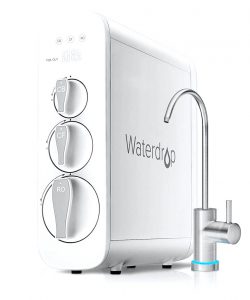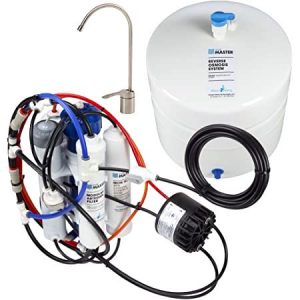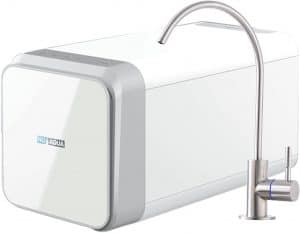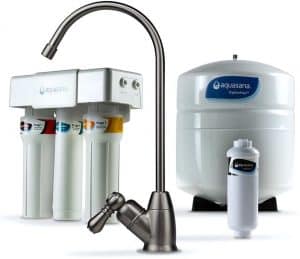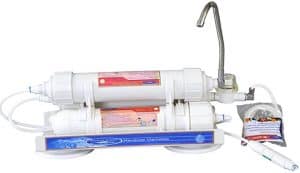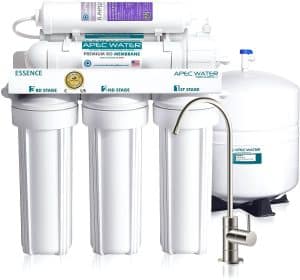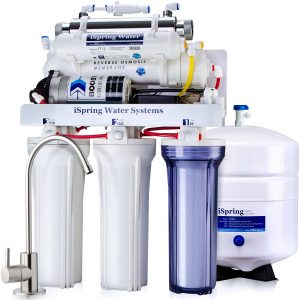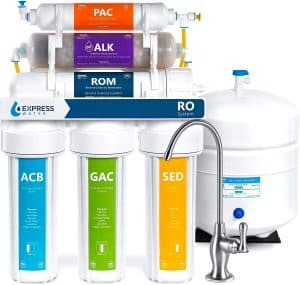Water is the source of life. Every living and non-living being needs water to survive. However, when we speak of humans, we need clean water for our survival. Gone are the days when people drank water directly from the water bodies. Thanks to the increase in different kinds of pollution that has affected the water bodies, finding clean water these days is a task.
However, realizing the growing need for clean water, experts have come up with a mechanism called the Reverse Osmosis System alias RO system.
An RO system is nothing but a technique that helps clean, unfiltered water or feed water, making it useable and drinkable.
Table of Contents
Top 10 Best Reverse Osmosis Systems
1. Best Overall: AquaTru Countertop Filtration System
A medium-range offering from AquaTru, the Countertop Filtration System certified to remove toxins, hormones, microplastics, cancer-linked contaminants, carcinogens, arsenic, lead, chromium, and drug residue toxins discovered in our tap water, filtered and bottled water.
Pros
- Tested and Certified by IAPMO according to NSF/ANSI standards
- Can remove 83 types of contaminants
- Needs no installation or plumbing. The countertop can be set up within no time.
- Is cost-effective and environment-friendly. The filter needs to be replaced every 6-12 months depending upon the water quality of your living place.
- The design is sleek and quite compact
Cons
- As it is a tabletop, you need a reasonably good platform space to place it.
- Because of the odd shape, though the dimensions are sleek, the RO system takes up more space in real.
2. Best Tankless RO System: Waterdrop WD-G3-W
Waterdrop RO water filtration system is an innovative, all-in-one intelligent water purification system. Is rated as the first intelligent RO system with composite filters and tankless design in the U. S. market.
Pros
- Is certified against NSF 58 for TDS reduction
- It is also NSF 372 certified for lead-free material
- In your tap water, it can remove a wide range of contaminants, including fluoride, TDS, limescale, and heavy metals.
- Use a 3-in-1 filter set up for purification.
- The tankless design consumes significantly less kitchen space
- The system is capable of filtering a cup of water in about 12 seconds.
Cons
- The machine, after installation, flushes out water for 30 minutes. After this, the water it releases is usable.
- While usage as well, the machine flushes out undrinkable water. However, this can be used for other purposes like washing, cleaning, etc.
3. Home Master TMHP HydroPerfection Reverse Osmosis System
Here comes yet another under-the-sink RO system. Home Master brings an under sink RO system that promises to be more effective than other RO systems. In addition, the system comes with a 5 years warranty.
Pros
- The RO system is registered under EPA #97952-AZ-1 and has been approved to kill, inactivate or suppress the growth of viruses, bacteria, fungi in water purification devices.
- It follows a 9 stage purification process that promises purification of any kind of water.
- The RO system meets the NSF standards for material safety and performance
Cons
- Needs more space under the sink for placement
- Improper installation may result in leakage and pipe damage
4. Top Pick: NU Aqua Efficiency Series Tankless Reverse Osmosis System
NU Aqua Efficiency Series Tankless RO system is stylish and useful. This tankless system is sleek and an innovative solution for pure water. The system comes with a 5 years warranty.
Pros
- With a 600 gallon per day flow rate, there is a need for a storage tank, and you have instant access to unlimited water.
- The machine comes with a faucet that allows the free flow of water.
- Has intelligent sensors that indicate when the filters need replacement.
- The installations process is simple and easy.
Cons
- 1 gallon of water is wasted for every 2 gallons
- If there is a problem, though the machine is simple, you would need an expert to address the issue.
5. Best for Well Water: Crystal Quest 1000C
Standing true to the name, this RO system is fixed under the sink to the water connection. As a result, the machine is compact with 16″L x 8″W x 21″H dimensions.
Pros
- This RO system has 12 filtration stages.
- The RO system is capable of removing the minutest pollutant from the water.
- Is capable of purifying 50 Gallons Per Day
- It can remove a wide range of contaminants, including Granulated Activated Coconut Shell Carbon (GAC) Filter Cartridge, a post membrane cartridge, to remove volatile organic carbon compounds (VOC’s), insecticides, pesticides, and industrial solvents.
Cons
- As the RO system is fixed underneath the sink, there is a high risk of causing leakage or pipe burst if not installed well.
- The machine needs to be checked for leakage and water pressure problems.
6. Aquasana OptimH2O Reverse Osmosis System
One of the known names in the RO system’s industry, Aqusana, brings an under sink RO system. With dimensions 30 x 50 x 12.5 inches, this RO system weighs 12.3Lbs.
Pros
- It can remove 95% of fluoride & 97% Of Chlorine, plus 99% of 86 other contaminants, including lead, mercury, asbestos, pharmaceuticals, and more.
- It is the first filter system to combine Reverse Osmosis, advanced Claryum filtration, and Remineralization technology.
- Filter replacement is easy and hassle-free
Cons
- While setting up, a plumber is a must. Additionally, as the RO system is an under sink setup, there is a possibility of a leakage when installment is not done effectively.
7. Crystal Quest Thunder Reverse Osmosis Water Filter
Suitable for all kinds of spaces like homes, offices, and more, this RO system is easy, hook up to the sink faucet system. The RO system measures 16″x7″x7″ in dimensions.
Pros
- Follows a 10 stage water filtration system.
- Is capable of removing contaminants as small as 1/10,000 of a micron
Cons
- Installation is slightly tricky
- Doesn’t have a filter change indicator
8. APEC Water Systems ROES-PH75
Designed and Engineered in the US, this RO system is quite famous and liked. The system is suitable for all kinds of water and promises consistent performance.
Pros
- This RO system follows a 6 stage purification process.
- Assures removal of 99% of contaminants such as chlorine, taste, odor, VOCs, and toxic fluoride, arsenic, lead, nitrates, heavy metals, and 1000+ impurities.
- WQA certified system
- America’s No.1 rated water filter brand with 20 years of success
- The RO system comes with a 100% lead-free designer faucet
Cons
- The system needs more space for installation
9. iSpring RCC1UP-AK 100GPD Reverse Osmosis Drinking Filtration System
iSpring brings their unique under sink RO system that is made using UV technology.
Pros
- The RO system follows a 7 stage filtration process and assures 99% of over 1,000 harmful contaminants like chlorine, fluoride, lead (removes up to 98%), arsenic, asbestos, calcium, sodium, and more.
- The RO system is installed with a sensor that automatically turns the purifier on and off with 3 minutes delay with water flow.
Cons
- The under-sink unit needs space
- Needs careful installation or can cause leakage.
- Doesn’t have an indicator for a filter change.
10. Express Water Alkaline Reverse Osmosis Filtration System
Experience pure water in express speed with Express Water Alkaline Reverse Osmosis Filtration System. With dimensions 19 x 18 x 19 inches, this RO system looks very much like its competitors in terms of design and shape.
Pros
- Has the ability to filter up to 99. 99% of Lead, Chlorine, Fluoride, Nitrates, Calcium, Arsenic, and more.
- comes with a 1-year warranty
- It comes with an emergency leak stop detector that shuts off water flow when it detects unwelcomed moisture.
Cons
- The unit may not fit into a small space as the RO system is an under-sink unit.
- There is a threat of leakage and pipe damage over some time.
Reverse Osmosis System Buying Guide
1. Decide whether you need an RO system: It is a misconception that every household needs it. However, the truth is that whether an RO is required depends on the quality of the water the municipality provides. If the TDS is above 250ppm, then opt for an RO water purification system.
2. What kind of RO system is needed: The water quality decides the kind and type of RO system you should choose. The type of RO system includes the technology and the design. First, what should be the technology depends on the water quality. The higher the TDS number better should be the quality of the RO system. Secondly, look at the design. Depending upon the space available in your kitchen, you need to choose an RO system that will easily slip into the space.
3. Check the filters: The capability of the RO system depends on the filters it has. Therefore, look for the filters the RO system that you choose has. This includes looking for filters like Mineral filter, UV, UF, and Manual TDS. Although you may not know what exactly they do, you must understand what makes them different.
4. Check the water storage capacity: In the Indian context, drinking water is needed quite frequently. However, complementing this high usage, there are also frequent power cuts. Therefore, the only way to balance this situation is to buy an RO system with good water storage capacity so that you do not need to run for clean water.
5. What are the installation and service charges like There are different RO systems with varying usage styles. For example, some are countertops, some are under the sink, and some are on the top models. Therefore, while you decide on the model, look at the type of installation and the cost the model has. Also, filter replacement and general maintenance expenses must be considered.
What’s Wrong With Unfiltered Water?
Unfiltered water also called “Raw Water,” is the water that you get in your taps. The majority of the public water systems gather water from the surface and ground. This water is released for public consumption after a certain amount of treatment. However, the fact remains that this water is exposed to contaminants capable of causing different health issues like diarrhea, sepsis, cholera, and other severe health problems if consumed on a long-term basis.
What is Reverse Osmosis?
Reverse Osmosis Systems alias RO can be defined as the process of treating unfiltered or raw water to make it drinkable.
How Does a Reverse Osmosis System Work?
It is the process wherein water pressure forces water molecules through an excellent membrane leaving the contaminants behind. Then, the purified water is released from the membrane, and the residue with concentrated contaminants is flushed down the drain from the backside.
What You Need to Consider When Buying an RO System for Your Home
-
- Certifications: Just like there is an ISO standard that is a universal benchmark to certify quality, there are some certifications like EPA #97952-AZ-1, NSF, and many more that assure the performance of the RO system. Therefore, while buying an RO system, you must check on the certifications the machine has. This will give you an assurance of the promise of purification the system offers.
- The Water Filtration Process: Different filters have different filtration processes. Some follow, 7 stages filtration, and some follow ten steps filtration process. Therefore, while buying an RO system, look for the filtration process the system follows. The process would define how effective the filtration process would be.
- RO Filter Style: Just like the filtration steps, each RO system has different filters. Most popular and high-end RO systems use some common filters: Mineral filter, UV, UF, and Manual TDS. However, each of these filters is different and unique in its way. Therefore, depending upon the quality of water you receive in your taps, choose an RO system with filters that can kill maximum contaminants.
- Water Demand: Depending on the capacity of the RO system, the system needs minimum water for purification.
- Installation And Filter Replacements: Depending on the RO system, the installation and filter replacements differ. For example, Countertop RO systems don’t need installation, whereas under-the-sink systems need more installation. The same rule applies to the filters. Depending on the capacity of the RO system, the quality of water, every filter has a shelf life and needs replacement. Most of the RO systems have filters that ideally need replacement within 6 months and maximum being 12 months.
- Water Pressure and Water Wastage: Water pressure plays in the operation of the RO system. Therefore, while buying an RO system, check the water pressure the machine demands. Ensure that your tap has that pressure. On the other hand, as part of the purification process, there is always a quantity of water containing concentrated contaminants. In some RO systems, 15-20% of the pure water generated is wastewater.
- Cost: Last but one of the crucial considerations while buying an RO system is the cost of the machine. When we say the system’s cost, you must consider the cost price of the RO system, the installation charges, and the overall maintenance charges the system demands. Compare the quantity of clean water the system releases and the overall cost.

Benefits Of Reverse Osmosis Filter Systems
-
- Removes Impurities: Most households rely on tap water for daily use and consumption. However, this water carries a lot of contaminants. Using an RO system assures removal of the pollutants to the minutest and makes the water safe to drink. The RO system is capable of killing all kinds of contaminants.
- Easy to Maintain: Over the years, a lot of RO systems have forayed into the market. Technology has evolved and thus making these machines easy to install and maintain as well. Most of the RO systems don’t even need a plumber for installation. They come with a manual and are like plug-in and use. There are countertops as well.
- Improves Taste: The RO systems in killing contaminants can also enhance the taste of the water. These systems sweeten or make the taste of the water neutral. Thus, they are not only clean but sweet as well.
- Cost-Effective: The health hazards of drinking contaminated can cost you badly in the long run. In such a scenario, installing an RO system in your house can prove to be a cost-effective investment for good health.
Contaminants Removed By Reverse Osmosis Filters
There is a wide range of contaminants found in water, and any sound RO system that removes are:
- Fluoride
- Salt
- Sediment
- Chlorine
- Arsenic
- VOCs
In addition to the above-mentioned vital contaminants, there are more than a RO system removes.
Reverse Osmosis System Efficiency Ratios
Compared to a regular water filter, RO systems are relatively slow, but the fact remains that these systems can purify more water per day than distillers. All RO systems don’t need electricity. However, one of the key drawbacks, RO systems do create wastewater. Four or more gallons of concentrated wastewater are flushed down the drain for every gallon of filtered water produced. There are no RO systems that promise zero wastage of water. Units that promise zero wastage run on the risk of re-injecting the concentrated wastewater back into the feeding space. However, the silver lining is that the wastewater released can be used for cleaning or washing purposes.
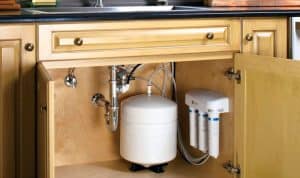
Is a Home Reverse Osmosis System Worth It? – Pros & Cons
Pros
- Intense removal of contaminants. They are considering that most of the tap water that households receive is filled with many contaminants, and the RO system proves to be a boon. Most of the leading RO systems ensure 99.99% of contaminants of water. In addition, the RO systems also promise to kill all kinds of contaminants, and they also improve the taste of the water.
- Cost-effective and environment: Most of the people to ensure safety from water-borne diseases tend to drink bottled. However, compared to the cost of bottled water cost, installing an RO system would prove economical. On the other hand, it is a known fact that the plastic and landfills that these bottles generate are adversely impacting the environment. In such a situation, installing an RO system can prove an eco-friendly option for pure water. The wastewater that RO systems are harmful to drink but have no adverse effects when used for cleaning or flush tanks.
- Ideal for cooking: Water is a key element in cooking. Be it at households, restaurants, or any other place, water is widely used in cooking. One may say that water is heated in the cooking process, so obviously, the contaminants are killed. Yes, they are killed, but what about the taste??? The taste of the water impacts the taste of the food. Therefore, using the RO system purified water in cooking promises zero scopes of contamination and helps improve the taste of the food.
Cons
- Wastage of water: It is a known fact that all RO systems release water as wastewater in the process of purification. 5%-15% of the water they filter is released as wastewater. This water, if not used or reused correctly, can prove to be a wastage of water.
- Use of disposed water: The wastewater that has contaminated elements must be utilized well. This water can be disposed of through the evaporation process. Or this water can be used in bathrooms in flush tanks. Or this water can also be recycled and used for cleaning.
- Utility threats: RO systems have specific utility issues like plumbing problems, leakage issues in the long run, and also filter replacement issues. Most of the RO systems do not have filtration replacement indicators.
Reverse Osmosis Water: Risks
Though the RO system promises the removal of contaminants, the other side of the coin is that experts say that drinking RO water for the long term also has some adverse health effects.
On the other hand, health experts say that drinking water with low mineral content increases the risk of experiencing health issues like hypertension and coronary heart disease, gastric and duodenal ulcers, chronic gastritis, goiter, complications during pregnancy.
Do You Need a Reverse Osmosis Filtration System?
Considering all the pros and cons and other factors, one may ask, is installing an RO system worthy? Then the answer would be yes. The answer is yes because if you look at the big picture, considering that the current tap is highly contaminated, using an RO system is necessary. However, the so-called side effects can be managed if you incorporate some healthy habits or shift to a healthy lifestyle, you can reduce the impact.
What Might Affect A Reverse Osmosis System’s Performance?
Following are the key factors that impact the performance of an RO system:
Temperature: The RO flow dramatically depends on the operating temperature. The higher the temperature of the water, the higher is the permeate flow. The temperature of the water not only impacts the quantity of water but also impacts the amount of salt passage through the membrane.
Pressure: When we say pressure, an RO system has various elements of force that impact the system’s functioning. This includes a pump or feed pressure, back pressure from line restrictions and storage tank, and osmotic pressure of the feed and permeates water.
Water quality: Most of the water that runs in the tap has TDS. Suppose the TDS is above 250ppm. Some cities have tap water that has a TDS of 1800ppm. The more salty and contaminated the water is, the sooner the filters would need replacement.
Reverse Osmosis Water Filter Maintenance
Most of the RO systems require very little maintenance. However, the only aspect of care is filter maintenance. The filters need cleaning or replacement (based on the filter type) in regular intervals. On average, no matter the model of RO system you have bought and the variety of filters it has, most of the filters need cleaning or replacement every 6-12 months. Some of the points that one must follow to assure the longevity of the RO system as a whole are as follows:
- When not in use, shut off the main valve completely
- Ensure you keep the body of the machine clean and dust-free.
- While installing, use good quality pipes to avoid any leakages.
Frequently Asked Questions (FAQ)
How to choose an RO for home?
You may be knowing the quality of your tap water because every locality has a particular source from where the water is provided. Based on the understanding of the water quality, your daily usage of clean water, and the space available in the kitchen, you can choose the model that best suits you.
What is the difference between RO and distiller?
Though both RO and distiller deliver the ultimate result is the same, i.e., “reduce the dissolved solids and make raw water drinkable,” the processes are different.
Which water is purer. RO or Distiller?
Though both remove contaminants, experts attest that the RO system manages to remove and kill more and minutest contaminants.
What is the longevity of RO systems?
When it comes to filters, the filters need replacement every 6-12 months. When it comes to the overall unit, any good unit will last for 3-5 years.
Does an RO system remove chlorine from water?
Yes, it does.
Do RO units need electricity?
No, as they run on water pressure. However, units that offer hot and cold water as outlets need electricity.
I have a water softener installed. Do I still need an RO system?
Yes. Water softener just reduces the harshness in the water, i.e., salt content. It doesn’t purify water. However, the RO system focuses on purifying the water and also improves the taste. Therefore, if you have a water softener installed, adding RO would ensure complete clean water. It also extends the longevity of the RO system.
Which is better, RO or UV water purifier?
In all means, experts suggest that RO purifiers are better than UV purifiers. UV purifiers can only disinfect the impure water whereas, RO purifiers remove all kinds of impurities and contaminants.
Which RO purifier is the best?
Currently, the market has many options, and almost all of them are equally good. However, the answer would be that your requirement will define which purifier is the best.
Is it true that using RO systems kills the minerals in water that are good for the body?
Yes, RO units to remove the mineral content. However, when we speak of healthy or palatable water, the focus is not on the minerals but the water’s chemicals. The minerals lost can be accrued from other food sources. Therefore, there is nothing to worry about.
Final Word
I hope this article gave you a detailed run-through of an RO system’s what, how, and why. Today, we often read news about our natural waters being flooded with industrial waste; it is loud and clear that clean water without any use of external support like RO systems is impossible. Considering that drinking contaminated water can affect the lives of all age groups, it has become more imperative that we all embrace using RO water purification systems at our homes and other places.



